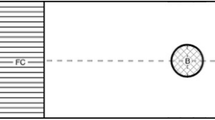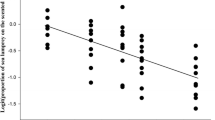Abstract
The reactions of preference and avoidance in response to humic-containing preparation (HCP) have been studied in four species of Baikalian amphipods and in Holarctic Gammarus lacustris Sars, 1863. The differences in the behavioral reactions of amphipods have been revealed. The order of amphipods in terms of the extent of HCP preference is as follows: G. lacustris > Gmelinoides fasciatus Stebbing, 1899 ≥ Eulimnogammarus flavus (Dybowski, 1874). The deepwater Ommatogammarus flavus (Dybowski, 1874) exhibited neither preference nor avoidance reactions in response to HCP. Potential relations between revealed reactions of amphipods, conditions, and depths of their habitats and spread off Lake Baikal are discussed.
Similar content being viewed by others
References
Bazikalova, A.Ya., Amphipods of Lake Baikal, Tr. Baikal. Limnol. St. AN SSSR, 1945, vol. 11, p. 440.
Braginskii, L.P. and Ignatyuk, A.A., Visually recorded responses of freshwater aquatic organisms as rapid indicators of aquatic toxicity, Gidrobiol. Zh., 2005, vol. 41, no. 4, pp. 89–103.
Veinberg, I.V. and Kamaltynov, R.M., Macrozoobenthic community of a pebble beach of Lake Baikal, Zool. Zh., 1998, vol. 7, no. 2, pp. 158–165.
Vetrov, V.A. and Kuznetsova, A.I., Mikroelementy v prirodnykh sredakh regiona ozera Baikal (Trace Elements in the Natural Environment of the Lake Baikal Region), Novosibirsk: SO RAN NITsOIGGM, 1997.
Votintsev, K.K., Meshcheryakova, A.I., and Popovskaya, V.I., Krugovorot organicheskogo veshchestva v ozere Baikal (Organic Matter Turnover in Lake Baikal), Novosibirsk: Nauka, 1975.
Galazii, G.I., Baikal v voprosakh i otvetakh (Baikal in Questions and Answers), Irkutsk: Vost.-Sib. Knizh. Izd., 1987.
Kamaltynov, R.M., Amphipods (Amphipoda: Gammaroidea), in Annotirovannyi spisok fauny ozera Baikal i ego vodosbornogo basseina (Annotated List of the Fauna of Lake Baikal and Its Catchment Area), Novosibirsk: Nauka, 2001, vol. 1, no. 1, pp. 572–831.
Kozhov, M.M., Biologiya ozera Baikal (Biology of Lake Baikal), Irkutsk: Izd. AN SSSR, 1962.
Lakin, G.F., Biometriya (Biometrics), Moscow: Vyssh. Shk., 1980.
Linnik, P.N., Vasil’chuk, T.A., and Linnik, R.P., Humic substances in natural waters and their importance for aquatic ecosystems (review), Gidrobiol. Zh., 2004, vol. 40, no. 1, pp. 81–107.
Stom, D.I. and Timofeev, M.A., The avoidance response of Gammarus lacustris Sars of Baikal water, Sib. Ekol. Zh., 1999, no. 6, pp. 649–653.
Tarasova, E.N. and Meshcheryakova, A.I., Sovremennoe sostoyanie gidrokhimicheskogo rezhima ozera Baikal (The Current State of the Hydrochemical Regime of Lake Baikal), Novosibirsk: Nauka, 1992.
Takhteev, V.V., Fauna bokoplavov pribrezhnoi zony Baikala v raione B. Kotov (The Amphipod Fauna of the Littoral Zone of Lake Baikal near Bol’shie Koty), Irkutsk: Izd. Irkutsk. Gos. Univ., 1993.
Takhteev, V.V., Ocherki o bokoplavakh ozera Baikal (sistematika, sravnitel’naya ekologiya, evolyutsiya) (Essays on Lake Baikal Amphipods (Taxonomy, Comparative Ecology, and Evolution).), Irkutsk: Izd. Irkutsk. Gos. Univ., 2000.
Timofeev, M.A., Ecological and physiological aspects of adaptation to abiotic environmental factors of endemic Baikalian and Palearctic amphipods, Extended Abstract of Doctoral (Biol.) Dissertation, Tomsk, 2010.
Timoshkin, O.A., Lake Baikal: the diversity of fauna, the problem of its immiscibility and origin, and ecology and “exotic” communities, in Annotirovannyi spisok fauny ozera Baikal i ego vodosbornogo basseina (Annotated List of the Fauna of Lake Baikal and Its Catchment Area), Novosibirsk: Nauka, 2001, vol. 1, no. 1, pp. 16–73.
Fedoseeva, E.V., Comparison of the effect of redox conditions of the environment on the survival and the behavioral responses of Baikalian amphipods and Holarctic Gammarus lacusrtis, Extended Abstract of Cand. Sci. (Biol.) Dissertation, Moscow, 2010.
Flerov, B.A., Ekologo-fiziologicheskie aspekty toksikologii presnovodnykh zhivotnykh (Ecological and Physiological Aspects of Toxicology of Freshwater Animals), Leningrad: Nauka, 1989.
Chertoprud, M.V., The fauna of amphipods (Crustacea, Amphipoda) of Moscow oblast, Biol. Vnutr. Vod, 2006, no. 4, pp. 17–21.
DeGraeve, G.M., Avoidance response of rainbow trout to phenol, Prog. Fish-Cult., 1982, vol. 44, no. 2, pp. 82–87.
Fowler, J., Cohen, L., and Jarvis, P., Practical Statistics for Field Biology, West Sussex: Wiley, 2003.
Haitzer, M., Höss, S., Traunspurger, W., and Steinberg, C.E.W., Effect of dissolved organic matter (DOM) on the bioconcentration of organic chemicals in aquatic organisms-a review, Chemosphere, 1998, no. 37, pp. 1335–1362.
Hayes, M.N.B., MacCarthy, P., Malcolm, R.L., and Swift, R.S., Humic substances II, in Search of Structure, New York: John-Wiley, 1989, pp. 339–372.
Kulikova, N.A., Stepanova, E.V., and Koroleva, O.V., Mitigating activity of humic substances: direct influence on biota, in Use of Humic Substances to Remediate Polluted Environments: from Theory to Practice, Dordrecht: Springer, 2005, pp. 285–309.
Leenher, J. and Croué, J., Characterizing dissolved aquatic organic matter, Environ. Sci. Technol., 2003, vol. 37, no. 1, pp. 19–26.
Lindstrom, M. and Fortelius, W., Swimming behaviour in Monoporeia affinis (Crustacea: Amphipoda)-Dependence on temperature and population density, J. Exp. Mar. Biol. Ecol., 2001, vol. 256, no. 1, pp. 73–83.
Meems, N., Steinberg, C.E.W., and Wiegand, C., Direct and interacting toxicological effects on the waterflea (Daphnia magna) by natural organic matter, synthetic humic substances and cypermethrin, Sci. Total Environ., 2004, vol. 319, pp. 123–136.
Meinelt, T., Schreckenbach, K., Knopf, K., et al., Humic substances increase the constitution of swordtail, Aquat. Sci., 2004, no. 66, pp. 239–245.
Paciolla, M.D., Davies, G., and Jansen, S.A., Generation of hydroxyl radicals from metal-loaded humic acids, Environ. Sci. Technol., 1999, vol. 33, no. 11, pp. 1814–1818.
Panov, V., Establishment of the Baikalian endemic amphipod Gmelinoides fasciatus in Lake Ladoga, Hydrobiologia, 1996, vol. 322, pp. 187–192.
Review of Sediment Management Standards. Bioassay Protocols, Produced for ecology’s environmental review, Sediment section by M. Stinson, Washington, Olympia: Washington State Department of Ecology, 1995.
Steinberg, C.E.W., Kamara, S., Prokhotskaya, V.Y., et al., Dissolved humic substances-ecological driving forces from the individual to the ecosystem level?, Freshwater Biol., 2006, vol. 51, pp. 1189–1210.
Steinberg, C.E.W., Paul, A., Pflugmacher, S., et al., Pure humic substances have the potential to act as xenobiotic chemicals: à review, Fresenius Environ. Bul., 2003, no. 12, pp. 391–401.
Taylor, E.J., Rees, E.M., and Pascoe, D., Mortality and a drift-related response of the freshwater amphipod Gammarus pulex (L.) exposed to natural sediments, acidification and copper, Aquat. Toxicol., 1994, vol. 29, nos. 1–2, pp. 83–101.
Thurman, E.M., Organic Geochemistry of Natural Waters, Dordrecht: Martinus Nijhof, Dr. W. Junk Publ., 1985.
Timofeyev, M.A., Shatilina, Z.M., Bedulina, D.S., et al., Natural organic matter (NOM) has the potential to modify the multixenobiotic resistance (MXR) activity in freshwater amphipods Eulimnogammarus cyaneus and E. verrucosus, Comp. Biochem. Physiol., 2007, no. 146 (Part B), pp. 496–503.
Vehoff, N.N., Waterlice from extra-tundra areas of Siberia and the Far East of Russia, with notes on systematics and zoogeography (Crustacea, Isopoda, Asellidae), Arthropoda Selecta, 1994, vol. 3, nos. 3–4, pp. 21–31.
Visser, S.A., Physiological action of humic substances on microbial cells, Soil Biol. Biochem., 1985, vol. 17, pp. 457–462.
Wang, F., Goulet, R.R., and Chapman, P.M., Testing sediment biological effects with the freshwater amphipod Hyalella azteca: the gap between laboratory and nature, Chemosphere, 2004, vol. 57, no. 11, pp. 1713–1724.
Yakimenko, O.S., Chemical and plant growth stimulatory properties in a variety of commercial humates, Humic Substances-Linking Structure to Functions, 2006, vol. 45-II, pp. 1017–1021.
Author information
Authors and Affiliations
Corresponding author
Additional information
Original Russian Text © E.V. Fedoseeva, D.I. Stom, 2015, published in Biologiya Vnutrennikh Vod, 2015, No. 2, pp. 32–38.
Rights and permissions
About this article
Cite this article
Fedoseeva, E.V., Stom, D.I. Preference and avoidance reactions in some Baikalian amphipods and holarctic Gammarus lacustris Sars, 1863 in response to a humic-containing preparation. Inland Water Biol 8, 130–135 (2015). https://doi.org/10.1134/S1995082915020066
Received:
Published:
Issue Date:
DOI: https://doi.org/10.1134/S1995082915020066




